Oribis in Uganda: Conservation Efforts, Habitats, and Importance
The Oribi (Ourebia ourebi) in Uganda. Uganda, often referred to as the “Pearl of Africa,” boasts a rich and diverse array of wildlife, with its national parks and reserves providing a sanctuary for numerous species. Among these, the Oribi (Ourebia ourebi) stands out as a fascinating and iconic antelope species that contributes to the country’s ecological balance. This article delves into the world of Oribis in Uganda, exploring their habitat, behavior, conservation status, and the efforts undertaken to ensure their survival.
Physical Characteristics:
Oribis are known for their distinct physical features, including a reddish-brown coat with a white underbelly and face. Both males and females have straight, slender horns that are ringed and can grow up to 18 inches in length. Their nimble build and sharp eyesight make them well-suited for life in the open grasslands where they can evade predators.
Behavior and Social Structure:
Oribis are primarily diurnal, meaning they are active during the day. They are often seen in small groups, typically consisting of family units or bachelor groups. The social structure is relatively loose, with individuals forming associations based on familial ties or common interests such as feeding. These herbivores graze on grasses and herbs, using their keen sense of smell and hearing to detect potential threats.
Habitat and Distribution:
Oribis are graceful and medium-sized antelopes that inhabit various regions of Uganda. Their preferred habitats include grasslands, savannas, and open woodland areas. These adaptable creatures can be found in national parks such as Queen Elizabeth National Park, Murchison Falls National Park, and Kidepo Valley National Park. Their ability to thrive in diverse ecosystems has contributed to their widespread distribution across the country.
Conservation Status: – The Oribi (Ourebia ourebi) in Uganda
While Oribis are not currently classified as endangered, they face threats that require continuous conservation efforts. Habitat loss due to human activities, such as agriculture and infrastructure development, poses a significant risk to their survival. Additionally, illegal hunting and poaching for their meat and hides contribute to the challenges facing Oribi populations.
Conservation Efforts:
Uganda has implemented various conservation initiatives to protect Oribis and their habitats. National parks play a crucial role in preserving these antelopes, providing safe havens where they can thrive. Conservationists and government agencies collaborate on anti-poaching measures, community education, and sustainable land management practices to mitigate the threats to Oribi populations.
Tourism and Education: – The Oribi (Ourebia ourebi) in Uganda
The presence of Oribis in Uganda’s national parks also contributes to the country’s tourism industry. Visitors from around the world come to witness these elegant antelopes in their natural habitat. Tourism revenue, when managed sustainably, can further support conservation efforts and local communities.
Conclusion: – The Oribi (Ourebia ourebi) in Uganda
Oribis in Uganda represent a vital component of the country’s rich biodiversity. As guardians of these majestic antelopes, it is our responsibility to ensure their survival by addressing the threats they face. Through continued conservation efforts, sustainable practices, and public awareness, Uganda can uphold its commitment to preserving the natural heritage embodied by the Oribis that roam its picturesque landscapes.








